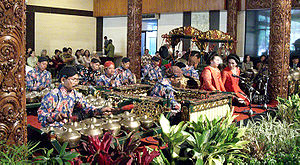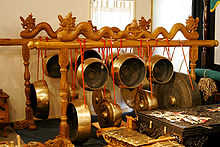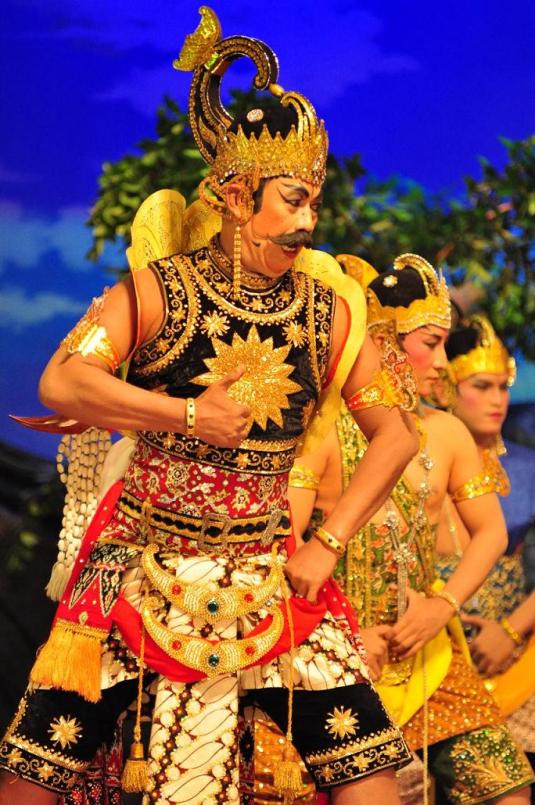 |
| Pandawa Water World Solo-Baru |
For several hundred years Solo has been known as the heart of Javanese culture and classical arts. It is the court city, the heart of the kingdom. Formerly, the royal families were the patrons of music, dance, weapon forging, gamelan (the instruments of the Javanese classsical orchestra) production, batik, weaving, and literature. Now, Solo is still the center of the preservation and development of Javanese arts and culture.
JAVANESE CLASSICAL MUSIC AND DANCE
 |
| The Gamelan Performing |
 |
| Gamelan |
 |
| The Bedhoyo Ketawang Dance |
 |
| The Srimpi Dance |
The Gambyong is a lively dance for welcoming guests while the Srimpi is a slow, controlled, elegant dance of graceful movement, especially of the arms, hands, fingers, and head, inspired by the quiet flow of peaceful water. The magical subtlety of these three regal dances, and many more, which are now open to the public, can be witnessed at palace performances, set in the original, mystical atmosphere.
WAYANG PERFORMANCES
 |
| Wayang Orang |
 |
| Wayang Kulit |
The delicate artistry put into the crafting of the colourful leather puppets is also remarkable. Made from a rather thick, parchment-like piece of leather which is chiselled and then punched out so that light can shine through, producing the exquisitely delicate shadows on the screen, each character is carefully gilded and painted and then attached to ahorn stick which the dalang uses to hold and move the puppets. All shadow play puppets are individual works of art, produced one by one by leather works artists who are also skilled painters.
BATIK
One of the most striking "sights" in Central Java, so unlike the extraordinary palaces, temples, and other ancient sites of classical interest, can be enjoyed daily by merely walking down the streets of Solo. Apart from the warmth and friend liness of the Solonese, an unforgetable color can be observed the bright colors of the batiks worn by a significant percentage of the population. Batik cloth and shirts are now used in the formal national dress of Indonesia. The batik processing is an intricate, classical art form that has had along and important role in Javanese tradition. There are scores of different motifs, each of which has special meaning, often symbolic, and are only used for certain formal occasions, such as wedding ceremonies, funerals or anniversaries. Batik is a dye-resistant process. Patterns are drawn on cloth with molten wax. When the wax hardens, it is dye-resistant, so, the unwaxed parts of the cloth can be dyed, while the waxed part is not affected. This process is repeated over and over again, depending on the pattern and the number of colors desired, by boiling the hardened wax off the cloth and applying a new wax pattern.
There are three basic ways to apply the wax : by hand, using a special copper tool for drawing; with a copper stamp; or a combination of hand and stamp. All three methods are fascinating art forms. Many hand drawn batiks, called batik tulis, take 2-3 months to make : that is, one piece of cloth 2 1/4 by 1 1/4 meters takes 60-90 days to create. For the production of the stamp batiks, callec cap, first a copper stamp must be made. This stamp is then used for the waxing process. The stamp is made by hand and so is the waxing process. The stamp which can be used for more than one piece of cloth, is more economical and less time consuming to use, but the outcome; is just as beautiful. It is often very difficult to distinguish between a hand drawn, a hand stamped, and a combination batik. The stamp them selves are oftem displayed as works of art. Batik production is one of Solo`s main industries and arts. Batik are produced for all purposes : for informal wear (colorful shirts, blouses, dresses, skirts, and even hats or shorts); for formal wear (the traditional kain, a piece of cloth wrapped around the body like skirt); and for home use (brilliant table cloths, table sets, napkins; as wall-hangings, ranging from traditional scenes to modern, abstract designs; and sheets, pillow cases and numerous accessories, from handbags to fans to slippers).
KERIS
The Keris, or dagger, is another magical, mysterious product of ancient Java. As an integral part of Javanese ceremony and ritual, it is worn by men for important occasions and for traditional rites. The artistry of forging the Javenese dagger dates back to ancient times, even before the Majapahit Kingdom (13 th century). The blade is made of a mixture of steel and meteorite, while the handle is usually made of teak or ather rare and valuable woods. Often gems, usually diamonds, rubies or sappphires, are inlaid near the base of the hilt. The sheathes are also works of art, frequently made of gold and inlaid with gems. Tradition has it that the artisans of the kerises, called empuh, were able to shape the blades with their bare hands, a power gained from spiritual and ascetic exercises. The kerises, too, are said to be magical : kerises are known to suddenly disappear into the blue;fly through the air; make noises when disturbed; appear in a dream only to be found a few days later; stand on the blade tip; or cause prosperity or disaster according to their suitability to their owners. The most precious kerises can be seen in museums throughout the country or on display in private collections.




No comments:
Post a Comment